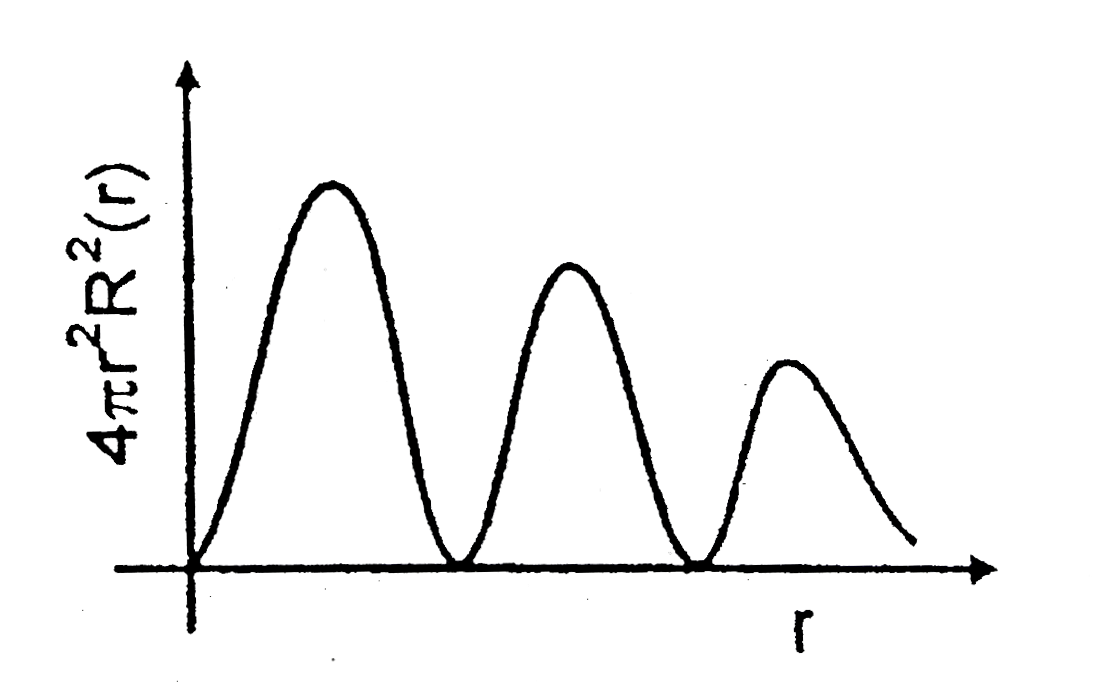For a 3s-orbital
where
What is the maximum radial distance of node from nucleus?
The correct Answer is:C
To find the maximum radial distance of the node from the nucleus for a 3s orbital, we will follow these steps:
1. Understand the Wave Function: The wave function for a 3s orbital is given by:
Φ(3s)=1a√3(1a0)3/2(6−6σ+σ2)e−σ/2
where σ=2rZ3aσ.
2. Set the Wave Function to Zero: To find the nodes, we need to set the wave function equal to zero:
6−6σ+σ2=0
3. Rearranging the Equation: Rearranging the quadratic equation gives us:
σ2−6σ+6=0
4. Using the Quadratic Formula: We can solve for σ using the quadratic formula:
σ=−b±√b2−4ac2a
Here, a=1, b=−6, and c=6:
σ=6±√(−6)2−4⋅1⋅62⋅1
σ=6±√36−242
σ=6±√122
σ=6±2√32
σ=3±√3
5. Choosing the Positive Root: We take the positive root for σ:
σ=3+√3
6. Relate σ to Radial Distance r: Recall that:
σ=2rZ3aσ
Rearranging gives:
r=3aσσ2Z
7. Substituting σ: Substitute σ=3+√3 into the equation for r:
r=3aσ(3+√3)2Z
Final Answer:
The maximum radial distance of the node from the nucleus is:
r=3aσ(3+√3)2Z
Φ(3s)=1a√3(1a0)3/2(6−6σ+σ2)e−σ/2
where σ=2rZ3aσ.
6−6σ+σ2=0
σ2−6σ+6=0
σ=−b±√b2−4ac2a
Here, a=1, b=−6, and c=6:
σ=6±√(−6)2−4⋅1⋅62⋅1
σ=6±√36−242
σ=6±√122
σ=6±2√32
σ=3±√3
σ=3+√3
σ=2rZ3aσ
Rearranging gives:
r=3aσσ2Z
r=3aσ(3+√3)2Z
The maximum radial distance of the node from the nucleus is:
r=3aσ(3+√3)2Z
Topper's Solved these Questions
- STOICHIOMETRY AND BALANCING REDOX REACTION Book:FIITJEEChapter:STOICHIOMETRY AND BALANCING REDOX REACTION Exercise:SINGLE INTEGER ANSWER TYPE QUESTIONS
Explore 5 Videos
- THERMODYNAMICS AND THERMOCHEMISTRY Book:FIITJEEChapter:THERMODYNAMICS AND THERMOCHEMISTRY Exercise:SINGLE INTEGER ANSWER TYPE QUESTIONS
Explore 5 Videos
Similar Questions
For a 3s - orbital, value of Φ is given by following realation:
Ψ(3s)=19√3(1a0)3/2(6−6σ+σ2)e−σ/2, where σ=2r.Z3a0
What is the maximum radial distance of node from nucleus?
View SolutionCalcuted the distance of spherical nodes for '3s' orbital from nucleus ?
R3s=19√3a3/20(6−6σ+σ2)eσ2 Where σ=2rna0
View Solution
Knowledge Check
According to qauntum mechanical model of H-like species, and electron can be represented by a wave function (ψ) which contain all dynamic information about the electron. The nature of wave function depends on the type of the orbital to which the electron belongs. For an orbital
ψ=[√281√3π](1a0)3/2(27−18σ+2σ2)eσ3
Where, σ=(Zra0),r = radial distance from nucleous, a0=52.9pm
The number of radial and angular nodes possible for the orbital given above are respectivelyAzero,zeroB0,2C2,0D2,1According to qauntum mechanical model of H-like species, and electron can be represented by a wave function (ψ) which contain all dynamic information about the electron. The nature of wave function depends on the type of the orbital to which the electron belongs. For an orbital
ψ=[√281√3π](1a0)3/2(27−18σ+2σ2)eσ3
Where, σ=(Zra0),r = radial distance from nucleous, a0=52.9±
Which of the following represents the position of one of the radial nodes?Ar=12(3+√3)a0Br=12(3−√3)a0Cr=32(3−√6)a0Dr=32(3+√3)a0According to qauntum mechanical model of H-like species, and electron can be represented by a wave function (ψ) which contain all dynamic information about the electron. The nature of wave function depends on the type of the orbital to which the electron belongs. For an orbital
ψ=[√281√3π](1a0)3/2(27−18σ+2σ2)eσ3
Where, σ=(Zra0),r = radial distance from nucleous, a0=52.9±
The orbital could possibly beA4sB4pC3sD3p
For an orbital in B+4 radial function is :
R(r)=19√6(za0)34(4−σ)σe−σ/2
where σ=Zra0 and a0=0.529Å,Z = atomic number, r= radial distance from nucleus.
The radial node of orbital is at distance from nucleous.
View SolutionGiven the H−atom Rn,l=19√3(1ao)3/2(6−6σ+σ2)e−σ/2
where σ=2Zrnao,ao=0.53Å
Select the correct statement for the given orbital ?

View SolutionThe Schrodinger wave equation for hydrogen atom of 4s- orbital is given by :
Ψ(r)=116√4(1a0)3/2[(σ2−1)(σ2−8σ+12)]e−σ/2 where a0=1st Bohr radius and σ=2ra0 . The distance from the nucleus where there will be no radial node will be :
View SolutionFor H-atom wave function for a particulaonstate is: Ψ=181√3π(1a0)3/2(σ2−10σ+25)e
Where σ=r/a0 and a0 is Bohr's radius (0.53∘A). Then distance of farthest radius mode is approximately.
View SolutionThe wave function of 3s and 3pz orbitals are given by :
Ψ3s=19√3(14π)1/2(Zσ0)3/2(6=6σ+σ)e−σ/2
Ψ3sz=19√6(34π)1/2(Zσ0)3/2(4−σ)σe−σ/2cos0,
σ=2Zrnα0
whereα0=1st Bohr radius , Z= charge number of nucleus, r= distance from nucleus.
From this we can conclude:
View Solution
